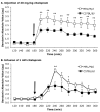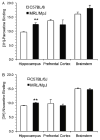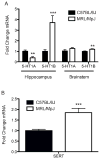Brain monoamines and antidepressant-like responses in MRL/MpJ versus C57BL/6J mice
- PMID: 23220293
- PMCID: PMC3587166
- DOI: 10.1016/j.neuropharm.2012.11.027
Brain monoamines and antidepressant-like responses in MRL/MpJ versus C57BL/6J mice
Abstract
The MRL/MpJ mouse demonstrates enhanced wound healing and tissue regeneration and increased neurotrophic mobilization to chronic antidepressant drug treatments. This study compared brain monoamine systems between MRL/MpJ and C57BL/6J mice as a potential basis for strain differences after chronic antidepressant treatment. MRL/MpJ mice had significantly higher tissue levels of serotonin and dopamine in multiple brain regions. Microdialysis studies demonstrated that baseline levels of extracellular serotonin did not differ between strains. However, acute administration of the selective serotonin reuptake inhibitor citalopram produced an increase in extracellular serotonin in the ventral hippocampus of MRL/MpJ mice that was twice as large as achieved in C57BL/6J mice. The greater effects in MRL/MpJ mice on 5-HT levels were not maintained after local perfusion of citalopram, suggesting that mechanisms outside of the hippocampus were responsible for the greater effect of citalopram after systemic injection. The density of serotonin and norepinephrine transporters in the hippocampus was significantly higher in MRL/MpJ mice. In addition, the expression of 5-HT(1A) mRNA was lower in the hippocampus, 5-HT(1B) mRNA was higher in the hippocampus and brainstem and SERT mRNA was higher in the brain stem of MRL/MpJ mice. The exaggerated neurotransmitter release in MRL/MpJ mice was accompanied by reduced baseline immobility in the tail suspension test and a greater reduction of immobility produced by citalopram or the tricyclic antidepressant desipramine. These data suggest that differences in the response to acute and chronic antidepressant treatments between the two strains could be attributed to differences in serotonin or catecholamine transmission.
Copyright © 2012 Elsevier Ltd. All rights reserved.
Figures





References
-
- Bel N, Artigas F. Fluvoxamine preferentially increases extracellular 5-hydroxytryptamine in the raphe nuclei: an in vivo microdialysis study. Eur J Pharmacol. 1992;229:101–103. - PubMed
-
- Brocco M, Dekeyne A, Veiga S, Girardon S, Millan MJ. Induction of hyperlocomotion in mice exposed to a novel environment by inhibition of serotonin reuptake. A pharmacological characterization of diverse classes of antidepressant agents. Pharmacol Biochem Behav. 2002;71:667–680. - PubMed
Publication types
MeSH terms
Substances
Grants and funding
LinkOut - more resources
Full Text Sources
Other Literature Sources
Medical
Molecular Biology Databases

